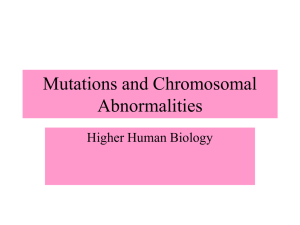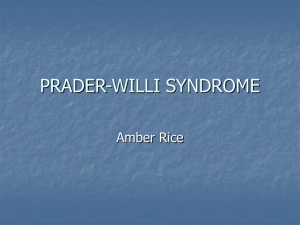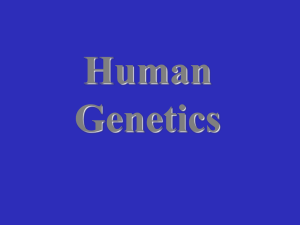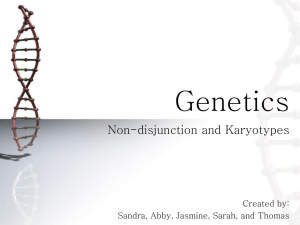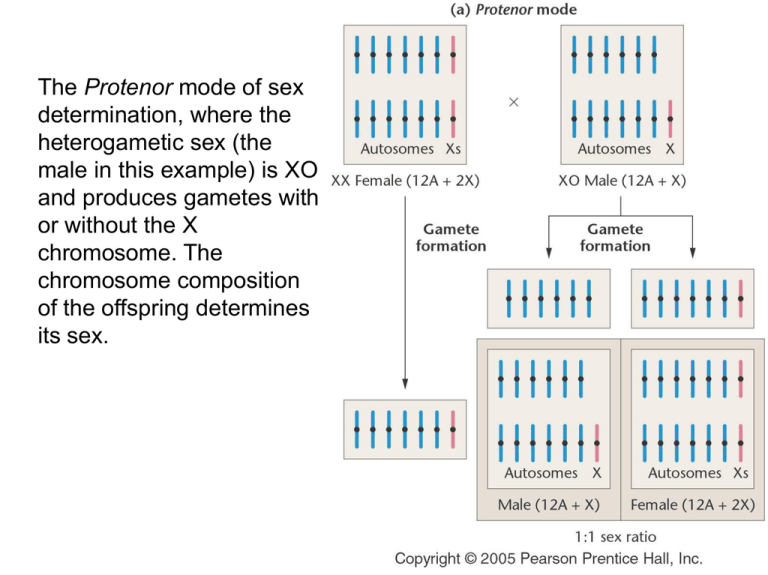
The Protenor mode of sex
determination, where the
heterogametic sex (the
male in this example) is XO
and produces gametes with
or without the X
chromosome. The
chromosome composition
of the offspring determines
its sex.
The Lygaeus mode of
sex determination,
where the
heterogametic sex
(again, the male in this
example) is XY and
produces gametes with
either an X or a Y
chromosome. In both
cases, the chromosome
composition of the
offspring determines its
sex.
The traditional human karyotypes derived from a normal female
and a normal male. Each contains 22 pairs of autosomes and two
sex chromosomes. The female (a) contains two identical X
chromosomes, while the male (b) contains one X and one Y
chromosome (the Y is often referred to as a heterochromosome).
Klinefelter Syndrome and Turner Syndrome Karyotypes
Klinefelter Syndrome
Turner Syndrome
Klinefelter’s syndrome, is undoubtedly one of the most severe genetic
diseases. In this syndrome, the patient has a chromosome abnormality: 47
chromosomes (instead of 46), which means chromosome aneuploidy! There
is an extra sex chromosome (X or Y). This can cause a variety of
behavioural and physical troubles. Doctor Harry Klinefelter first found and
described it (in 1942). The frequency of Klinefelter Syndrome is 1 every
500~1000 males.
The most important symptom is the male infertility. Some other symptoms
are the presence of small testes, inability to produce sperms, a very
characteristic rounded body type. Thepatients can have difficulties in
reading, writing, or even language problems
One of the most successful ways of treating this severe disorder is by using
testosterone injections,very effective when it takes place during the first
years of the patient’s life. When the disorder is diagnosed during the
adulthood, the testosterone treatment is not so successful.
Turner syndrome encompasses several conditions, of
which monosomy X (absence of an entire sex
chromosome, the Barr body) is most common. Typical
females have two X chromosomes, but in Occurring in 1
in 2000[3] – 1 in 5000 phenotypic females,[4] the
syndrome manifests itself in a number of ways, such as
short stature, swelling, broad chest, low hairline, low-set
ears, and webbed necks. Girls with Turner syndrome
typically experience gonadal dysfunction (non-working
ovaries), which results in amenorrhea (absence of
menstrual cycle) and sterility. Concurrent health
concerns are also frequently present, including
congenital heart disease, hypothyroidism (reduced
hormone secretion by the thyroid), diabetes, etc. A
specific pattern of cognitive deficits is often observed,
with particular difficulties in visuospatial, mathematical,
and memory areas.[7]
Turner's syndrome
Cardiovascular
Bicuspid aortic valve
Coarctation of the aorta
Thoracic aortic aneurysm (aortic root
dilatation)
Skeletal
Short stature
Short fourth metacarpal/matatarsal bone
may be unusually short (+/- short 3rd
and 5th).
Osteoporosis (due to lack of estrogen)
Scoliosis
Reproductive
Women with Turner syndrome are
almost universally infertile.
XYY syndrome
Not to be confused with XXY
(Klinefelter's syndrome).
XYY syndrome is an aneuploidy (abnormal number) of the sex
chromosomes in which a human male receives an extra Ychromosome, giving a total of 47 chromosomes instead of the
more usual 46. This produces a 47,XYY karyotype. This
condition is usually asymptomatic and affects 1 in 1000 male
births.
Some medical geneticists question whether the term "syndrome"
is appropriate for this condition because its phenotype is normal
and the vast majority (an estimated 97% in the UK) of 47,XYY
males do not know their karyotype.[1
In June 1970, The XYY Man was published—the first of seven Kenneth
Royce spy novels whose fictional tall, intelligent, nonviolent XYY hero
was a reformed expert cat burglar recruited by British intelligence for
dangerous assignments—and later adapted into a thirteen-episode
British summer television series broadcast in 1976 and 1977.[46] In other
fictional television works, a January 1971 episode "By the Pricking of
My Thumbs ..." of the British science fiction TV series Doomwatch
featured a 16-year-old XYY boy expelled from school because of his
genetic condition,[47] a November 1993 episode "Born Bad" of the
American police procedural TV series Law & Order portrayed a 14year-old XYY sociopathic murderer,[48] and the May 2007 season
finale episode "Born To Kill" of the American police procedural TV
series CSI: Miami depicted a 34-year-old XYY serial killer.[49] The
false stereotype of XYY boys and men as violent criminals has also
been used as a plot device in the horror films Il gatto a nove code in
February 1971 (dubbed into English as The Cat o' Nine Tails in May
1971) and Alien³ in May 1992.[30][31]
In December 1970, at the annual meeting of the American
Association for the Advancement of Science (AAAS), its
retiring president, geneticist H. Bentley Glass, cheered
by the legalization of abortion in New York,
envisioned a future where pregnant women would be
required by the government to abort XYY "sex
deviants". Mischaracterization of the XYY genetic
condition was quickly incorporated into high school
biology textbooks. and medical school psychiatry
textbooks, where misinformation still persists decades
later.
In August 1976, Science published a study by
Educational Testing Service psychologist Herman
Witkin and colleagues that screened the tallest 16%
of men (over 6'0" in height) born in Copenhagen
from 1944–1947 for XXY and XYY karyotypes,
and found an increased rate of minor criminal
convictions for property crimes among sixteen
XXY and twelve XYY men may be related to the
lower intelligence of those with criminal
convictions, but found no evidence that XXY or
XYY men were inclined to be aggressive or violent.
Triple X syndrome
Triple X syndrome is a form of chromosomal variation
characterized by the presence of an extra X chromosome in each
cell of a human female. A female affected by triple-X syndrome has
an XX pair of chromosomes, as well as an additional chromosome,
resulting in the formation of XXX. A mosaic form also occurs
where only a percentage of body cell contain XXX while the
remainder carry XX. The extent to which an individual is affected by
the condition will depend upon the proportion of XXX to XX
throughout. The condition is also known as triplo-X, trisomy X,
XXX syndrome, and 47,XXX aneuploidy. Triple X results during
division of a parent's reproductive cells and occurs about once in
every 1,000 births. Unlike most other chromosomal conditions (such
as Down syndrome), there is usually no distinguishable difference
to the naked eye between women with triple X and the rest of the
female population.
Occurrence of Barr
bodies in various
human karyotypes,
where all X
chromosomes
except one (N - 1)
are inactivated.
MORE RARE SYNDROMES
XXXX syndrome (also called tetrasomy X, quadruple X, or
48, XXXX) is a rare chromosomal disorder caused by the
presence of four X chromosomes instead of two X
chromosomes. This condition occurs only in females, as there are
no Y chromosomes present. Tetrasomy X was first described in
1961, and since then approximately 100 cases have been
reported worldwide. Approximately 60 females have been
described in medical literature with this condition Symptoms of
tetrasomy X are highly variable, ranging from relatively mild to
severe.
XXXXX syndrome (also called pentasomy X or 49,XXXXX)
is the presence of three additional X chromosomes. Diagnosis is
done by karyotyping. Approximately 25 females have been
described in medical literature worldwide with this extremely
rare condition. XXXXX syndrome causes mental, growth, and
motor retardation.
The ratios of X
chromosomes to sets of
autosomes, and the
resultant sexual
morphology in Drosophila
melanogaster.
The normal diploid
male chromosome
composition is shown
as a reference on the
left (XY/2A).


